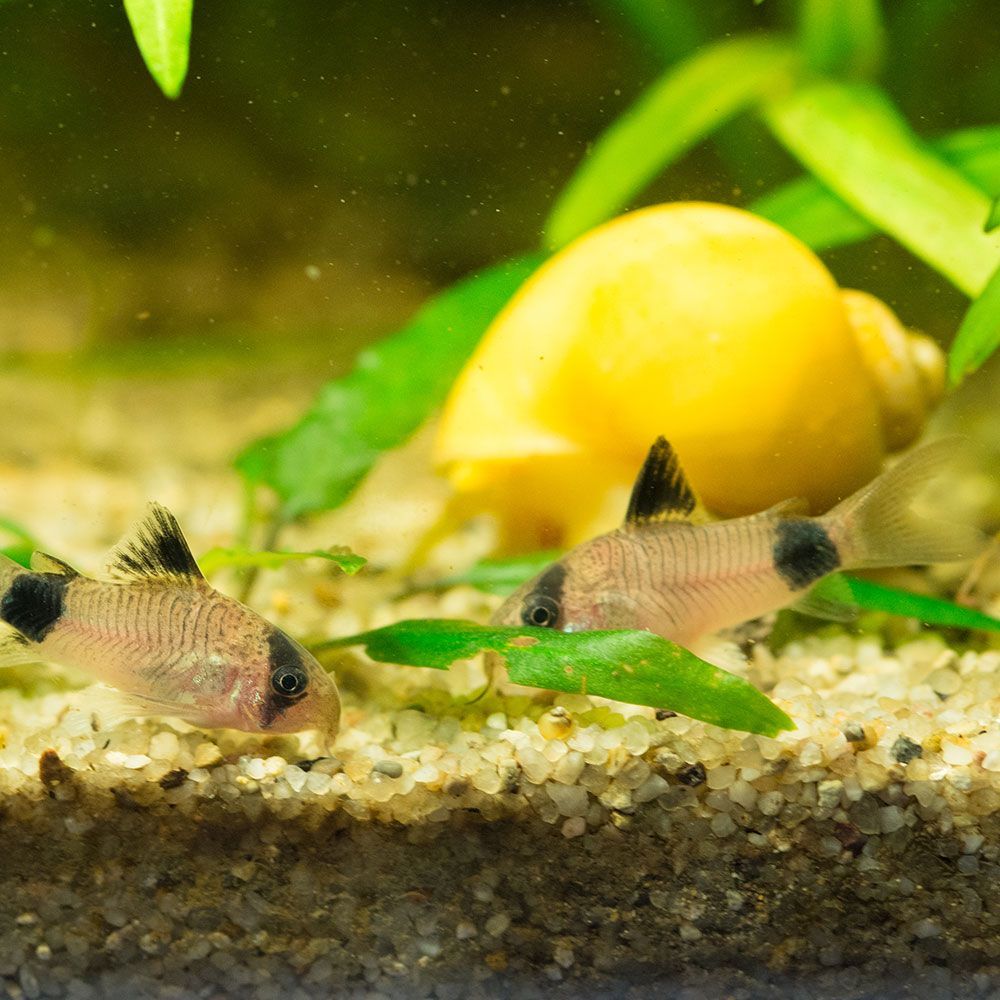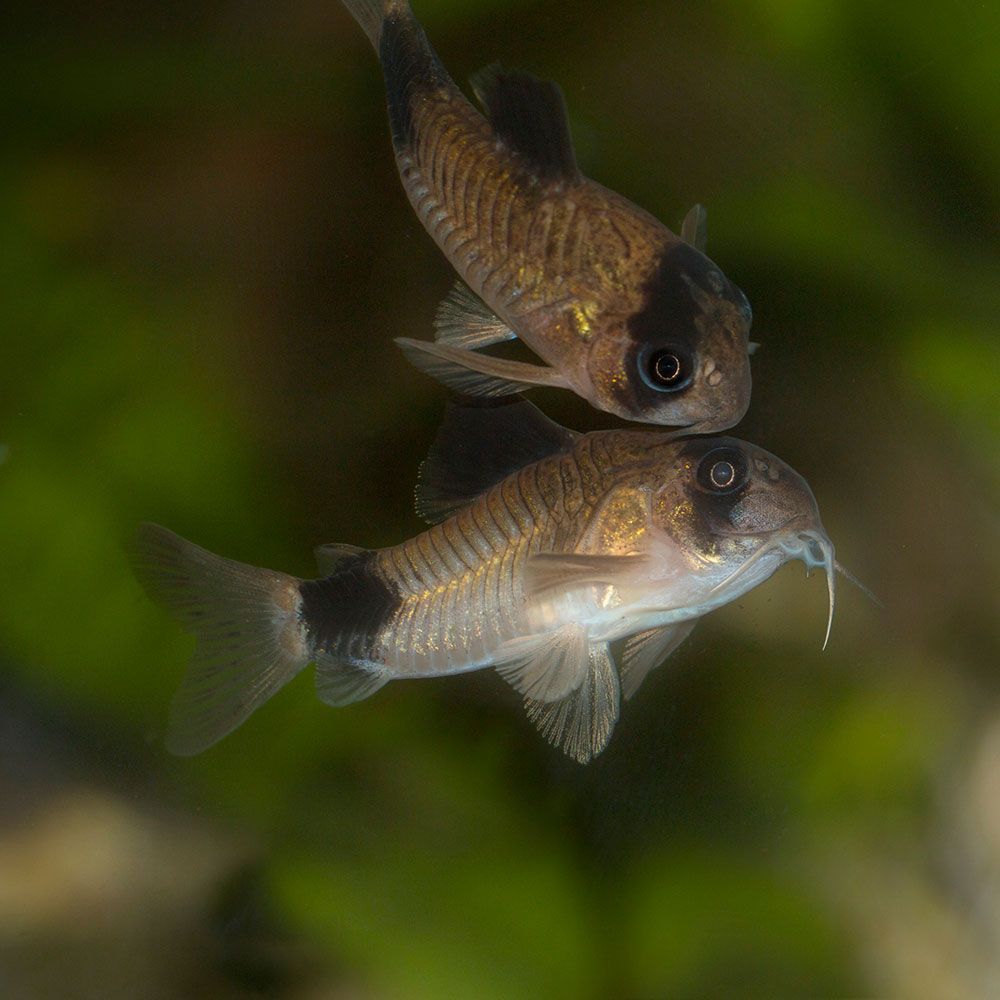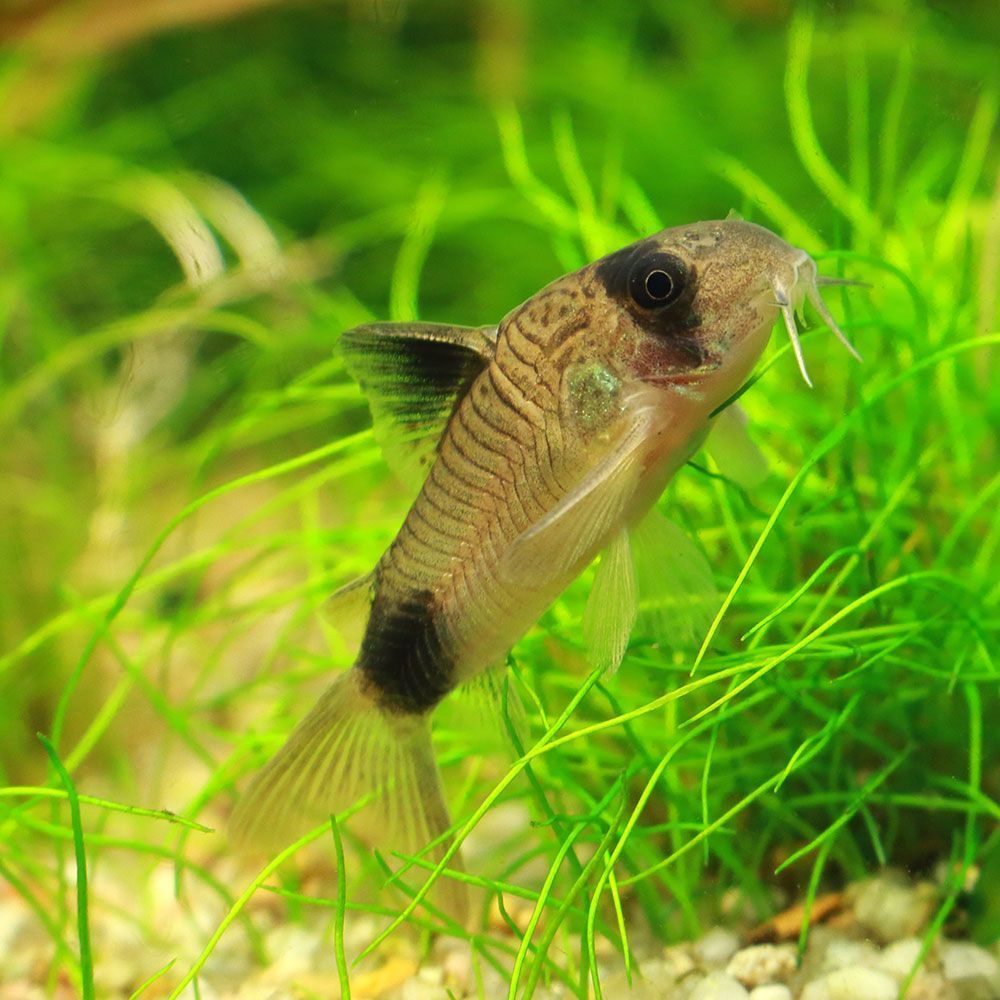This fish explores and modifies the substrate on its adventure to find more food. So, beginner aquarists don’t need to worry a lot about them.
If you want to add this fantastic fish to your tank, keep reading!
What is a Panda Cory Catfish?
The panda cory catfish is a tremendous hardy or armored schooling fish for freshwater aquariums. It is visually stimulating and is also an excellent tank cleaner.
| Origin | Upper Amazon River basin of South America; Peru, Ecuador in Huanaco region. |
| Order | Siluriformes |
| Family | Callichthyidae |
| Scientific Name | Corydoras panda |
| Common Names | Panda cory, panda corydoras, panda catfish |
| IUCN Red List Status | Near Threatened |
| Appearance | Off-white, beige, to pinkish body and fin color. A black blotch on almost the entire dorsal fin and around the eyes like a panda. |
| Size | Up to 3.8 cm (1.49 in) |
| Lifespan | Up to 10 years |
| Temperament | Peaceful |
| Tank Level | Bottom dwellers |
| Water Temperature | 72-79 °F (22-26 °C) |
| pH Level | 5.8-7.0 |
| Water Hardness | 2-25 dGH |
| Care Level | Easy |
| Minimum Tank Size | 20 gallons for about eight panda cories |
| Tank Environment | Tank with a clean and soft substrate, well-maintained water temperature, and plenty of hiding space. |
| Diet | Omnivorous; but prefers carnivorous meals |
| Tank Mates | Peaceful small species, other panda cories |
What is the Natural Habitat for Panda Cory Catfish?
In nature, the fish is mainly found in the upper Amazon River basin in Peru and Ecuador, South America.
It is more commonly spotted in the Huanaco region of Rio Aquas, Rio Amarillo, Rio Ucayali, and one Rio Pachitea tributary. Its specimen was also found in the Apurimac River Valley.
The species is found in fast-flowing clear river water, rich in oxygen and has soft sand or fine gravel substrate.
The water in these rivers flows in after the Andean snow melts, which shows that the fish prefers cool water.
The IUCN Red List of Threatened Species last assessed the species in 2014 and labeled it as Near Threatened.
Which family does Panda Cory Catfish belong?
The fish belongs to the family Callichthyidae under the order Siluriformes. Its scientific name is Corydoras panda, commonly known as panda cory, panda corydoras, and panda catfish.
Fun Fact: The fish is most energetic after dusk due to limited light, and it feels more confident to explore your tank during this time.
How does Panda Cory Catfish look?

The panda cory appears broadest around the back of its head. This is right in front of its dorsal fin. The remainder of its body is slimmer. But let’s understand its appearance in detail, below!
What is the Size of Panda Cory Catfish?
Usually, the standard length of the adult fish is about 3.8 cm or 1.49 in. However, the female fish is slightly longer.
What is the Color of Panda Cory Catfish?
The body color of panda catfish may vary from off-white or beige to a pinkish-orange ground color. However, in certain lights, you might notice its flanks and operculum appear a light green iridescence.
The fins also have the same color as the body. If you look closely, the fins will appear translucent. The dorsal fin has a black blotch covering almost the entire fin.
It also has a black patch around the eyes (that descends from its fontanel), similar to pandas. The adipose fin sometimes has a black pigment.
What are the Features of Panda Cory Catfish?
Its fin spine supports the adipose fin. The pectoral fins are behind its operculum. When the fish rests, the pectoral fins become horizontal, like airplane wings.
The pelvic fins are on the ventral side of the fish, a little behind its pectoral fins.
The first ray of the dorsal fin emerges from the point of greatest elevation of the fish body. From that point, a vertical line goes downwards until where the pelvic fins are attached.
The anal fins are right behind its ventral side. The first ray of the anal fin is slightly in front of the black caudal peduncle mark.
Its body is covered with a bony plate, aka scutes. The demarcation line of each scute is visible only on close observation.
This species has three pairs of barbels: maxillary barbels (one pair) and rictal barbels (two pairs).
How does a male and a female Panda Cory Catfish differ?
The female fish can be differentiated due to its larger, longer, and stouter body frame. Its abdomen is rounder and stockier than males. This becomes more prominent when the female fish carries eggs.
The male fish has a more slender and flat body.
In the wild, the mature female is usually 5.5 cm (2.1 in). However, captivity-bred ones won’t be as long. It will only be slightly longer than captivity-bred males.
What is the behavior of Panda Cory Catfish in the tank?
It is a friendly and peaceful fish. It prefers to live in groups with other panda cories. If not, it can also form a social group with other cory catfish species.
If any other species interferes in its area, it doesn’t act territorial. It is also diurnal, i.e., it sleeps at night and stays awake during the day.
What is the Lifespan of Panda Cory Catfish?
In good living conditions, the fish can live up to 10 years. In rare cases, this can be even as long as 15 years.
Author’s Note: You can hardly sustain it longer than 5 years if you don’t maintain all the necessary living conditions.
How to take care of Panda Cory Catfish?

Though the panda cory is a beginner-friendly pet fish, it has some special needs. So, let’s know how to care for them the best here.
What is the Tank Size of Panda Cory Catfish?
You can put a group of panda cory in a 20-gallon tank. However, if you want to add more tank mates, go for a bigger tank.
What is the Water Chemistry required for Panda Cory Catfish?
You must be extremely careful about a tank dedicated to panda cories. Make sure to follow these water conditions strictly.
- pH Levels: 5.8-7.0
- Water Temperature: 72-79 °F (22-26 °C)
- Water Hardness: 2-12 dGH
- Ammonia: 0 ppm
- Nitrite: 0 ppm
- Nitrate: Below 20 ppm
What is the Tank Environment for Panda Cory Catfish?
The tank environment must impersonate the natural habitat of Amazonian rivers. You can get a better idea through the list:
What type of Substrate does Panda Cory Catfish need?
The fish likes to scavenge around in the tank for leftover food from other fish at the bottom. Only use soft and fine sand. Gravel is usually not recommended as it might be too coarse for cories. Otherwise, its sensitive barbels may fall off.
What are the Plants required for Panda Cory Catfish?
Live and floating aquatic plants give the fish ample hiding space. It also creates a shaded area, making the fish more confident to swim around. However, you can also use other decor items for that.
You can also add java moss for the egg repository during spawning.
Which type of Lighting does Panda Cory Catfish require?
The fish is more comfortable in fairly dim lighting.
What is the Décor required for Panda Cory Catfish?
Add caves and rocks to make it feel at home. You can also add driftwood and dried leaves. You can take any other branches rich in tannin as they make the water acidic, which is suitable for the species. But don’t let them stay for too long or the water will get polluted.
Which type of Filtration is required for Panda Cory Catfish?
Do not use an under-gravel filtration system as it might injure their barbel. Stick to canister filtration.
What is the Water Flow Rate required for Panda Cory Catfish?
Since the fish is native to fast-flowing rivers of South America, you can choose a medium and above water flow rate.
Fish Care Tip: Ensure the tank temperature never exceeds 82 °F (28 °C). Always try to maintain a clean tank. Otherwise, you won’t be able to sustain the fish until its full lifespan.
What does Panda Cory Catfish eat?
Many say that the fish is omnivorous. However, it is highly greedy for a carnivorous diet. So, it thrives on live food like:
- Bloodworms
- Daphnia
- Cultivated brine shrimp
- Brine shrimp eggs
- Freeze-dried Tubifex worms
- High-grade flake food containing shrimp
- Crustaceans
- Insects
As it’s omnivorous, it can also consume algae. However, don’t expect it to clean all the algae in your tank.
What are the Tank Mates for Panda Cory Catfish?
It prefers to live with its own species. So, you must keep around 7-8 panda cories together.
Since it is a peaceful species, you can keep them with other similarly-sized, peaceful tank mates as follows:
- Any schooling fish
- Clown loaches
- Dwarf cichlids
- Small catfish
- Invertebrates
- Livebearers
- Sterba’s cory
- Rummynose and other medium-sized tetras
- German blue ram
- Danios
- Rasboras
- Aspidoras
If you choose tank mates other than the listed ones, avoid fishes that swim on the same tank level as them. Otherwise, the panda catfish will hardly have enough space for itself.
Which Tank Mates to Avoid for Panda Cory Catfish?
Don’t keep it with aggressive, territorial, and bigger fish like tiger barbs. They will either eat or hurt your cory by nipping its fins or barbels.
What are the Common Diseases in Panda Cory Catfish?
Though hardy, this fish is susceptible to some diseases. If you don’t pay proper attention to it, its lifespan might get reduced significantly. So, be prepared to deal with these diseases:
| Disease Name | Causes | Symptoms | Treatment |
|---|---|---|---|
| Columnaris | Bacterial infection | White to grey patches, frayed fins, lack of appetite, drowsiness | Antibiotics, water quality improvement, stress reduction |
| Ich | Protozoan parasite | Flashing, white spots, lack of appetite, drowsiness | Temperature elevation (but not beyond ), aquarium salt addition, or ich medicine |
| Fin rotting | Bacterial infection | Frayed fins, discoloration or red marks on fins, lack of appetite, drowsiness | Water quality improvement, removing physical injury sources, and antibiotics |
| Red blotch disease | Bacterial infection, lack of oxygen | Red sores on the belly, blisters, white dead skin | Medicine like Seachem KanaPlex, API furan 2 Slow oxygenation of water or addition of oxygenated water |
| Nitrite poisoning | High nitrite/nitrate concentration in tank | Fast breathing, slow and tired swimming, swimming in top water layer, lying on tank bottom at one spot for long periods, avoids eating | Frequent (30%) water change, less frequent meals to avoid nitrite production from decaying food |
Caution: Always maintain top-notch aquarium water and environmental conditions to avoid stressing the fish. Otherwise, it might release a toxin and make itself and other tank mates sick.
How to Breed Panda Cory Catfish in a tank?
Panda cories can be stimulated to reproduce by mimicking the natural habitat water during the beginning of the rainy season.
For this, you must add clean and fresh oxygenated water into your tank. You can also drop the water temperature slightly. But unlike other cories, this fish doesn’t usually spawn with temperature variations.
What is the Mating Ritual for Panda Cory Catfish?
Multiple male panda cories chase one female fish when they feel stimulated. They rub their barbels with the female fish’s barbels to stimulate her. They also rub her caudal peduncle, fontanel, and the front of her head.
The female fish only pays attention to the males’ chasing when she has mature eggs within her reproductive tract.
In the end, one male successfully courts the female fish. When the female fish responds to the courting, both fish form a T-shaped position.
The male puts his pectoral fins near the mouth of the female. He secures her barbels between his pectoral fin and body. This stimulates the male enough to release sperm in the female’s mouth.
This is not yet scientifically explained, but in my experience, the female seems to direct the sperm to her pelvic fins. This way, she fertilizes two eggs at a time and lays the sticky egg in a secure, leafy vegetated space.
The same process continues for 4-5 hours until she fertilizes and deposits 25 eggs in a single spawning. Both males compete to get her attention.
When do Panda Cory Catfish eggs hatch?
After 3-4 days, the eggs hatch at a steady temperature of 22 °C (72 °F). However, if the water is cooler, the hatching will take longer.
Development of the Fry
The fry is 4 mm long and almost invisible. However, you will notice a slight ground coloration, fully developed barbels, and a hint of dark patches around the eyes. The features become prominent as it grows.
It has a fin fold (incessant integrated membrane), which resembles a tadpole’s back. After 4 weeks, the fish is 8-9 mm, and its finfold grows into differentiated and discontinuous dorsal, anal, and caudal fins.
The fry also becomes the color of the adult fish. Soon after, the caudal peduncle and dorsal fin patches appear. You will also notice fine black dots between the patches.
After 10-12 weeks, the fry becomes 1.2-1.4 cm long and turns into a smaller version of the full-fledged adult.
To sustain the fry, keep the temperature around 22 °C (72 °F) or below until the first 21 days of life. Beyond 26 °C (79 °F), the fry won’t survive. You can also feed the fry infusoria or prepared foods.
Breeding Tip: To breed this fish, always put more males than females. The female fish produces too many eggs (100) for one male fish to fertilize. Moreover, the females also take time to respond to males and act picky.
A word from FishInAquarium
The panda cory loves to swim around in your tank in groups which makes your tank extremely attractive.
However, it would help if you always kept cories in groups. Otherwise, it will cause unnecessary stress to your aquatic companion. While it may add up to your expenses, it will definitely be worth the investment!
If you’re satisfied with everything you learned about this fish, don’t forget to share it with other enthusiasts. And if some other question is bugging your mind, drop us a mail anytime, and we’ll get back to you!


